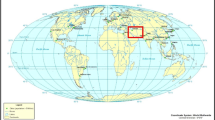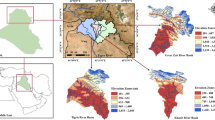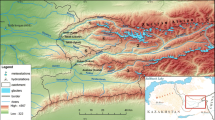Abstract
In Algeria, the climate change in recent decades has a negative impact on water resources. The goal of this study is to determine the influence of these hazards on surface water resources in the basin of Macta (Northwest of Algeria). The study of climatic pulsations is implemented from the climate coefficient changes and its moving averages over 3 years. Variations of this coefficient based on years, for the period 1949–1973, show an alternation of wet and dry years. Starting from 1973, a very dry period of more than 20 years was installed in the basin, with deficits ranging from 22% to 72%. The consequences of the surface water deficit can damage the environmental balance and consequently affect the various human activities that are directly or indirectly related to the use of these resources.
Similar content being viewed by others
Avoid common mistakes on your manuscript.
Introduction
Several recent climatic events of great magnitude have pushed the global community to address climate change and its impacts on water resources. These events include the drought that affected the Maghreb countries in general and Algeria in particular since the 1970s (Laborde 1993; Meddi 2001; Meddi and Humbert 2000; Meddi and Meddi 2004; Talia and Meddi 2004; Kingumbi 2006; Lahache et al. 2008; Laftouhi 2007).
Studies have highlighted the impacts of climate change on water resources in Algeria (Meddi and Hubert 2003; Talia 2003; Meddi et al. 2006). The runoff evolution interests many users in different applications (hydrology, agronomy, water management, etc.). The climate changes in the recent decades have a negative influence on the water resource (groundwater recharge, filling of reservoir dams and on agricultural yields).
The study of hydrometric series conducted over a long period allows the assessment of the sensitivity of rivers to changes in climate.
Physical characteristics of the basin
Located in the north of Algeria, the Macta basin covers an area of 14,380 km². It is bounded in the North West by the Tessala Mountain, in the south by the high plains of Maalif, in the west by the plains of Telagh and in the east by the mountains of Saida.
The Macta basin is crossed by two major rivers—in the East, the Mekerra Wadi and in the West, the El Hammam Wadi (Fig. 1). It is composed of eight sub-basins (Table 1).
Oued El Hammam
The watershed of the Oued el Hammam covers an area of 7,550 km². The main stream length is 150 km, it is drained by three major tributaries, and the principal elementary basins are: Fekan (1,200 km2), Sahwet (2,200 km2) and Saida (400 km2).
Oued Mekerra
The area of the Mekerra wadi basin is about 1,890 km². It is bounded in the north by the Tessala mountains, which are crossed by the Mekerra wadi to reach the marshes of Macta without throwing directly to the sea, in the west by the Beni Chougrane mountains and the Hammam wadi.
The climate and rainfall
In general, the Macta basin is under the Northern Mediterranean influence in the north and the continental influence in the south, where the climate is arid and dry with cold winters and hot summers.
The annual rainfall in the region varies between 280 mm in the southern basin and 600 mm in the mountains of Beni Chougrane. The rainy years are three to four times higher than the driest years.
The study of the interannual variability over the period 1930–1999/2000 for the regions of the West (Talia 2003; Talia and Meddi 2004) shows that the largest number of years in deficit was observed during the decades 40, 80 and 90. These results also show the persistence of total loss that continued over several successive years. Between these two major drought periods, rainfall was generally normal or excess; it was recorded seven consecutive wet years between the late 1940s and early 1950s at the station of Ain Fekan (Fig. 2).
The driest hydrological year since 1930 is observed in the early 1940s (1944–1945); during these years, annual total rainfall reached 166 mm at the station of Ain Fekane. A change point in annual rainfall time series in the stationarity of the rainfall series occurred during the decade 1970–1980 and since this date, the decrease in annual rainfall has become a reality (Talia 2003; Meddi et al. 2002).
Data
The hydrometric data were selected to provide a basis of annual and monthly data as complete and as representative as possible of the study area. Sample of stations, obey to the duration of information and data quality criteria. The stations were selected according to the length of available flow records and their geographical positions in order to better cover the whole region and the different climatic influences. Eight gauging stations were selected on the studied region.
Data were taken from the two organizations responsible for network runoff in Algeria, namely the National Agency of Hydraulic Resources and the National Meteorological Office.
Methods used
The climatic events that affected the Macta basin based on a hydrological study of rivers of this basin will be underlined. The used approach has been used by many researchers around the world (Probst and Tardy 1985; Olivry 1983; Haida et al. 1999).
To highlight the hydroclimatology interannual variations, this study is based on annual average flows of different stations in the Macta basin. The adopted technique is the difference (Ec) of annual average flows to the interannual flow:
This technique, used by Riehl and Meitin (1979) on the Nile, by Probst and Tardy (1987) on major rivers worldwide and Haida et al. (1999) in Sebaou in Morocco, distinguishes the wet periods (increasing curve) from the dry periods (decreasing curve).We have arranged the annual average flows in eight classes. The boundaries of those classes correspond to the degree of moisture drawn from the rate of deviation of the mean annual flow to the interannual flow (Table 2) (Haida et al. 1999; Talia 2003).
To show up the hydroclimatic periods, the average of the hydroclimatic coefficient (Chm) was calculated for all stations. For each, the differences were weighted by the size of the corresponding sub-basin to redraw the climatic periods:
where n: number of stations; Ec i : deviation of annual average flow and the interannual flow; S i : area of sub-basin (square kilometre); and S ex : basin area at the station furthest downstream (square kilometre).
This coefficient was used to trace the major hydroclimatic periods in the Aquitaine basin (France) by Probst and Tardy in 1985 and Haida et al. in 1999 in the Sebaou Basin (Morocco) and also by Talia in 2003 in the Tafna basin (Algeria).
Results
Analysis of the temporal variability of runoff
The annual runoff
From the studied hydrological characteristics (Table 3), we deduce that:
-
The ratio of extreme modules defined by Pardi (1943) is greater than 4 for all stations. Therefore, according to the classification established by Pardi, the regime is Mediterranean type.
-
The hydrological regime is irregular, and the dispersion around the mean time series of average annual flow is strong (Fig. 3).
The monthly runoff
At this scale, we have shown seasonal variations using graphs. A high-water period during which focus floods spread of the month from September to May is distinguished (Fig. 4).
This even distribution of monthly flows was found by Meddi (1992) in the Mina basin (western Algeria). The value of October, which is superior to others, is due to the concentration of floods in the autumn months. For example, the average monthly discharge of October 1966 is 6.22 m3/s at the station of Sidi Bel Abes on Mekerra wadi and 72.65 m3/s at the station of Three Rivers on the El Hammam Wadi (maximum hourly flow equal to 1,400 m3/s). The average monthly discharge in October 1986 was about 4.01 m3/s at the station of Sidi Bel Abes on Mekerra wadi (maximum hourly flow equal to 104 m3/s) and from 31.1 m3/s at the station of Three Rivers on the El Hammam Wadi (maximum hourly flow equal to 564.2 m3/s).
For the month of May, very high monthly flow values are recorded. For example, the average monthly flow of May 1948 is 3.03 m3/s at the station of Sidi Bel Abes on Mekerra wadi (maximum hourly flow equal to 70 m3/s) and 14.95 m3/s at the station of Three Rivières on the El Hammam Wadi (maximum hourly flow equal to 728 m3/s). The average monthly flow of October 1990 is 6.16 m3/s at the station of Sidi Bel Abes on Mekerra wadi (maximum hourly flow equal to 61.7 m3/s) and 24.28 m3/s at the station of Three Rivers on the El Hammam Wadi (maximum hourly flow equal to 892 m3/s).
The region of Sidi Bel Abbes is periodically affected by floods. The city of Sidi Bel Abbes is exposed to very important flood with repetition. The flood of 1940 caused considerable damage, which cost 40 billion dinars (440,000,000 euros). This region is located at a lower level than the bed of the Wadi Mekerra. The flood of September 1994 (530 m3/s) has caused two deaths and left 22 affected families. The month of October 1986 (500 m3/s) resulted in one death, 530 people homeless and 200 affected families. The flood in this region is cyclical.
Sidi Bel Abbes and the Three Rivers
Hydroclimatology fluctuations
The objective of this approach is the evaluation of changes in hydroclimatology regime in Macta basin.
From Table 3, we deduce that there is a hydrological difference between the two major oueds in the West, the Mekerra Wadi and in the east, the El Hammam Wadi. Through the comparison of the flow of these two wadis, the interannual average flow of the Mekerra wadi varies between 0.15 m3/s (station of Hacaiba) and 0.97 m3/s (station of Sidi Bel Abbes), while for the stations of El Hammam Wadi, the values of these range from 0.20 m3/s (station of Hacine) and 3.69 m3/s (station of Three Rivers).
The results obtained allow comparison of the behaviour of three sub-basins: Ain Fekane, Oued Taria and Sidi Bel Abbes, in deficit year and in surplus years.For the multi-annual scale, changes in hydrological regimes of the Macta basin reveal a general irregularities trend throughout the basin.
These irregularities or climatic pulsations can be studied from the variation of the annual mean climate coefficient (Chm) and its moving average over 3 years. We took to calculate this coefficient of the three sub-basins, namely Sidi Ali Ben Youb, Sidi Bel Abbes and Three Rivers. The evolution of this coefficient for the period 1949–2001 (common to all three stations) is shown in Fig. 5.
Variations of this coefficient according to years show that during the period between 1949 and 1963, the Macta basin has known a very important deficit sequence followed by a surplus period not exceeding three consecutive years (Fig. 6). During these periods, there are also years with an exceptional climate character: 1950–1951 with a surplus around 170%.
From 1972–1973, a very dry period of more than 20 years was installed on the basin, with deficits ranging from 22% to 72%.
However, the observed hydroclimatic fluctuations on such long periods can be generalized to all stations in the basin. The study of stationarity series of flows for all stations in the Macta basin has shown a negative trend in the late 1970s and early 1980s (Table 4; Talia 2003). The results are similar to those found for the Tafna basin where the reduction of flow to Beni Bahdel dam reached 67%.
Conclusion
Before 1973, a persistent alternation of wet and dry episodes is observed. After 1973, a net continuous decrease of average flows is distinguished; this decrease reached its peak from 1992 to 1996. From 1972–1973, a very dry period of more than 19 years was installed on the basin, with deficits ranging from 22% to 72%.
The rainfall and hydrological deficits reinforce the difference between important needs of water of a growing population and the water resources which can be mobilized. These changes are currently pushing policymakers to rethink about the types of crops that can adapt to the new climate of certain regions of the country, particularly in western Algeria.
References
Haida S, Probst JL, Snoussi M (1999) Hydrologie et fluctuations hydroclimatiques dans le bassin versant du Sebaou entre 1940 et 1994. Sécheresse 10(3):221–226
Kingumbi A (2006) Modélisation hydrologique d’un bassin affecté par des changements d’occupation. Cas du Merguellil en Tunisie Centrale. Thèse de Doctorat, Université de Tuinis El Manar, 2006, p. 300
Laborde JP (1993) Carte pluviométrique de l’Algérie du Nord à l’échelle du 1/500 000, notice explicative. Agence Nationale des Ressources Hydrauliques, projet PNUD/ALG/88/021
Laftouhi N (2007) Impact des variations climatiques sur les ressources en eau en régions semi arides; Cas du bassin versant du Qsob (Essaouira Maroc), Journée Mondiale de l’eau 22 mars 2007. Faculté des Sciences Semlalia de Marrakech
Lahache RG et al. (2008) Projection des ressources en eau de la Tunisie sous les effets des changements climatiques globaux. XIIIth World Water Congress, Montpellier, France, 1–4 Sept 2008
Meddi (1992) Hydropluviométrie et transport solide dans le bassin de l'Oued Mina. Thèse de doctorat de l'Université Louis Pasteur Strasbourg, France, p. 320
Meddi H (2001) Quantification des précipitations: application au nord ouest algérien- méthodologie Pluvia. Mémoire de magister, C.U. Mascara, p. 160
Meddi M, Hubert P (2003) Impact de la modification du régime pluviométrique sur les ressources en eau du Nord-Ouest de l’Algérie. Hydrology of the Mediterranean and semiarid regions. IAHS 278:1–7
Meddi M, Humbert J (2000) Variabilité pluviométrique dans l’ouest Algérien durant les cinq dernieres décennies. Publication de l’Association Internationale de Climatologie 13:266–274. Edité par Panagiotis MAHERAS.
Meddi H, Meddi M (2004) Sècheresse et spatialisation des précipitations dans le nord-ouest de l’Algérie. Colloque International «Terre et Eau», Université d’Annaba, 4–6 Dec 2004.
Meddi M, Hubert P, Bendjoudi H (2002) Evolution du régime pluviométrique du Nord-Ouest de l’Algérie. Actes du colloque international sur l’eau dans le Bassin Méditerranéen: Ressources et développement Durable, Tunisie
Meddi M, Talia A, Bekoussa BS (2006) Evolution du régime hydro-pluviométrique du bassin versant de la Tafna (Nord Ouest de l’Algérie). Congrès International sur la gestion intégrée des ressources en eaux et défis du développement durable. Université Cadi Ayad Marrakech, 23–25 May 2006
Olivry JC (1983) Le point en 1982 sur l’évolution de la sécheresse en Sénégambie et aux Iles du Cap Vert. Examen de quelques séries de longue durée (débits et précipitations). Cahier O.R.O.S.T.O.M., sér. Hydrol 20(1): 47–69
Pardi M (1943) Cours de potamologie. Grenoble, Ecole des Ingénieurs hydrauliciens, vol. 2, p. 70
Probst JL, Tardy Y (1985) Fluctuations hydroclimatiques du Bassin d’Aquitaine au cours des 70 dernières années. Rev Géol Dyn et Géogr Phys 26(1):59–76
Probst JL, Tardy Y (1987) Long range stream flow and world continental runoff fluctuations since the beginning of this century. J Hydrol 94:289–311
Riehl H, Meitin J (1979) Discharge of the Nile River: a barometer of short-period climate variation. Science 206(4423):1178–1179
Talia A (2003) Evolution des régimes pluviométrique et hydrologique du Nord de l’Algérie. Mémoire de Magistère, Université de Mascara, Algérie, p. 160
Talia A, Meddi M (2004) la pluvio-variabilité dans le nord de l’Algerie. Colloque International «Terre et Eau», Université d’Annaba, 4–6 Dec 2004.
Author information
Authors and Affiliations
Corresponding author
Rights and permissions
About this article
Cite this article
Mohamed, M.M., Talia, A. Runoff evolution in Macta basin (Northwest of Algeria). Arab J Geosci 6, 35–41 (2013). https://doi.org/10.1007/s12517-011-0318-3
Received:
Accepted:
Published:
Issue Date:
DOI: https://doi.org/10.1007/s12517-011-0318-3










